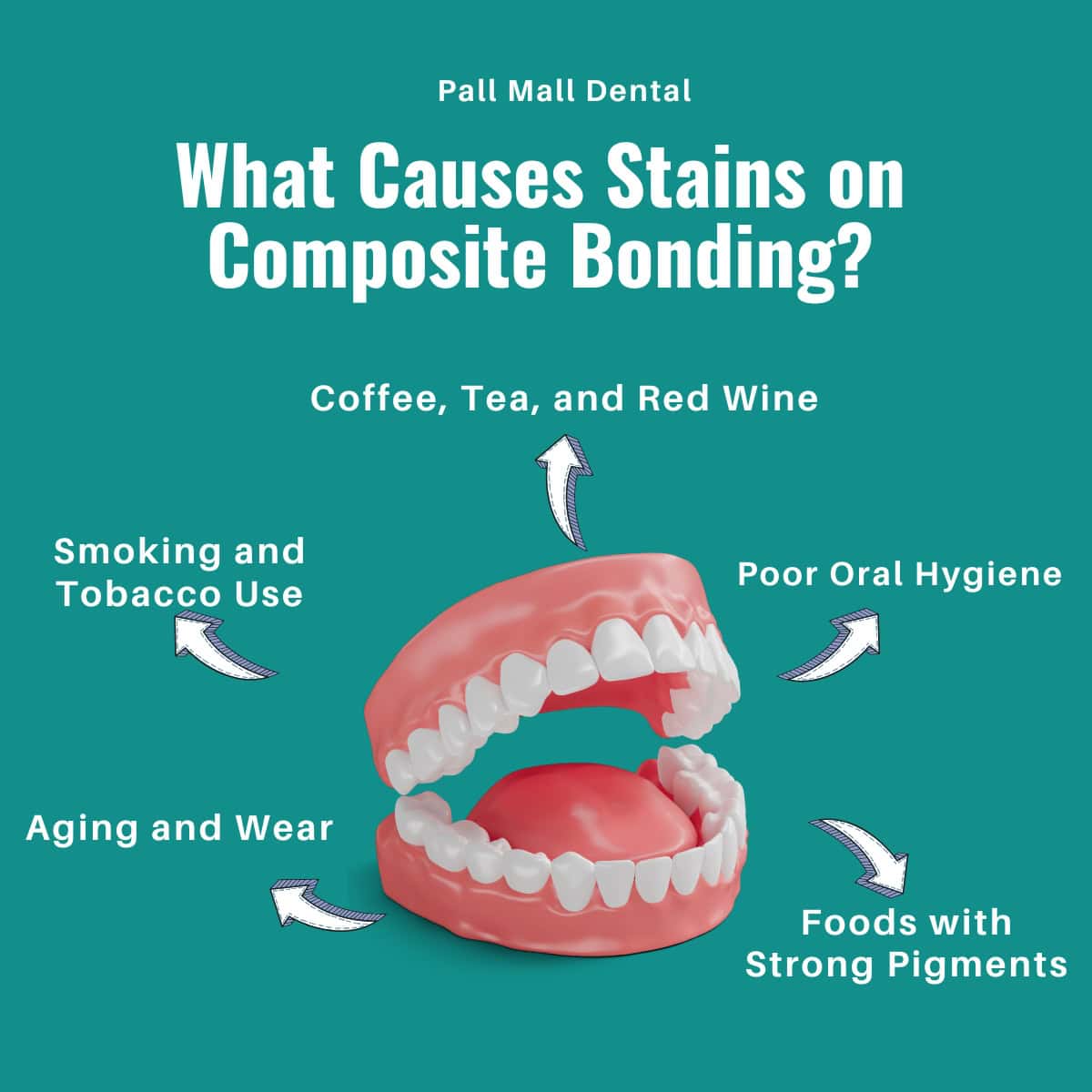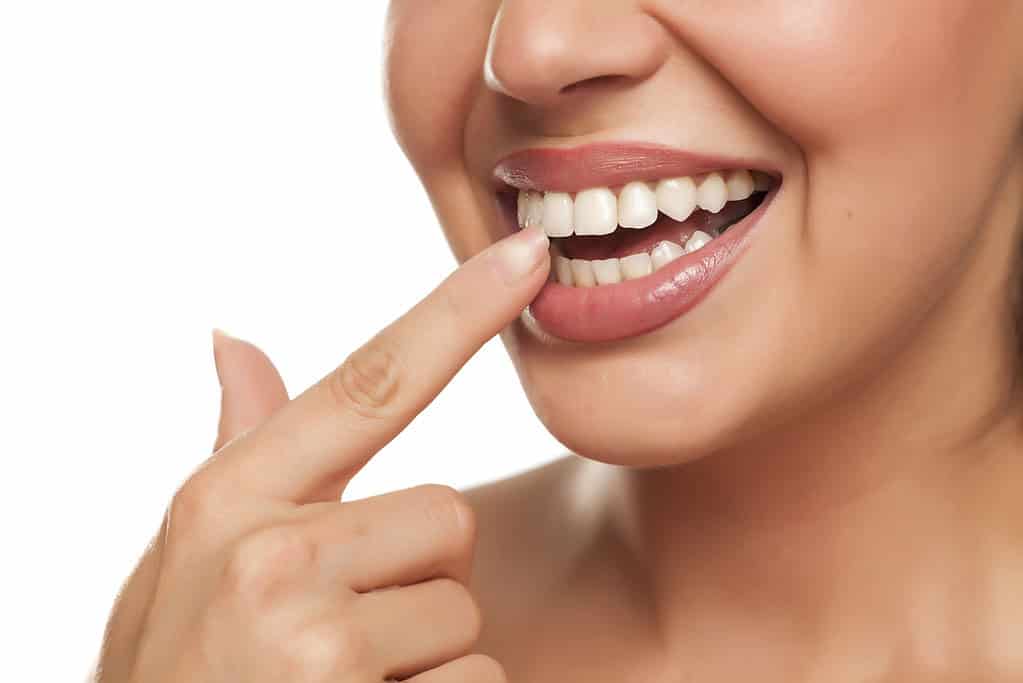Let’s show you how you can remove stains from composite bonding.
In case you don’t know; over time, bonded teeth can lose their sparkle due to staining from food, drinks, or lifestyle habits. But the good news is that you can bring back that bright, flawless look with a few simple steps and the right care.
In this guide, we’ll walk you through everything you need to know to tackle those stains and keep your composite bonding looking its best. Keep reading for the steps you need to take when you notice your bonded tooth is getting discoloured.
Does Composite Bonding Stain?
Unfortunately, composite bonding can stain, much like your natural teeth.
While the material used for bonding is durable and designed to blend seamlessly with your smile, it’s not completely resistant to discolouration. Everyday factors like coffee, tea, or smoking can cause staining over time.
However, the truth is that many people aren’t aware of this and assume their bonded teeth will stay pristine without extra care. So, they leave their smile vulnerable to unwanted discolouration.
However, with the right habits and techniques, you can keep your bonded teeth looking fresh and bright for longer.
But before we show you how to remove stains from dental bonding, let’s quickly see some of the reasons bonded teeth get stained or discoloured in the first place.
What Are Some Common Causes of Stain on Composite Bonding?
Let’s be honest – life happens, and so do stains. Just like natural teeth, dental bonding can pick up discolouration from the things we eat, drink, and do every day. Here are some common culprits:
- Coffee, Tea, and Red Wine
These drinks are classic stain offenders. Their deep pigments can cling to the surface of your bonded teeth, leaving them dull over time. - Smoking and Tobacco Use
Nicotine and tar from smoking or chewing tobacco can leave yellow or brown stains on your teeth, including bonded areas. - Foods with Strong Pigments
Tomato-based sauces, curry, soy sauce, and even berries can leave behind stains if consumed frequently. - Poor Oral Hygiene
Not brushing or flossing properly can allow plaque and debris to build up, making your bonded teeth more prone to discolouration. - Abrasive Toothpaste
Using a gritty or overly abrasive toothpaste can cause tiny scratches on the composite surface, which then trap stains more easily. - Aging and Wear
Over time, the surface of the composite can wear down, making it slightly rougher and more susceptible to staining.
How to Remove Stains from Composite Bonding at Home
Many people wonder if they can whiten their bonded teeth at home. The truth is that traditional whitening products like over-the-counter strips or gels won’t work on composite bonding the way they do on natural teeth.
However, there are some simple steps you can take at home to reduce stains and keep your bonding looking its best:
- Brush with Non-Abrasive Toothpaste
Use a gentle toothpaste specifically designed for stain removal, such as one for sensitive teeth. Avoid abrasive formulas, as they can scratch the composite surface and make it more prone to staining. - Rinse After Staining Foods or Drinks
If you’ve had coffee, tea, or red wine, rinse your mouth with water immediately afterwards. This simple habit can wash away pigments before they have a chance to settle on your teeth. - Try Baking Soda Occasionally
For mild surface stains, a small amount of baking soda mixed with water can act as a natural, gentle cleaner. Use it sparingly and avoid vigorous scrubbing to protect the composite. - Hydrogen Peroxide Rinse
A diluted hydrogen peroxide rinse (half water, half peroxide) can help lift surface stains. Swish it around for about 30 seconds, then rinse thoroughly with water. Do this occasionally, not daily.
While these steps can help manage minor staining, deeper discolouration usually requires professional attention.
If you are in Liverpool and looking for where to remove stains from composite bonding, give us a call at Pall Mall Dental to help brighten your bonded teeth and get your smile back on track. Call us now!
3 Ways a Dentist Can Help Remove Stains from Composite Bonding
While at-home remedies can help with mild stains, deeper discolouration on teeth bonding often requires professional care. If you’re dealing with stubborn stains, visiting your dentist is the best way to restore your smile.
Here are three effective methods an experienced dentist can use to remove stains from composite bonding and improve its appearance:
Professional Polishing
Dentists have a specialised polishing technique they use to gently remove stains from composite bonding without damaging the material. This process smooths the surface of the bonding, eliminating discolouration and giving it a fresh, natural look.
Professional polishing is a quick and effective solution for moderate staining and is often part of a routine dental cleaning.
Bonding Restoration
If stains are deeply embedded or the bonding material has become worn over time, your dentist may recommend replacing the stained composite with fresh bonding.
During this process, the old material is carefully removed, and a new composite is applied and shaped to blend seamlessly with your natural teeth. Bonding restoration not only removes stains but also revitalises the overall appearance of your smile.
Porcelain Veneers
For patients dealing with significant discolouration or who want a more durable and stain-resistant option, porcelain veneers are an excellent choice.
Veneers are thin shells that cover the front of your teeth, offering a long-lasting, flawless finish. Unlike composite bonding, porcelain veneers are highly resistant to stains. This makes them ideal for achieving a bright, worry-free smile.
Tips for Maintaining Stain-Free Composite Bonding
Keeping your bonding bright and stain-free doesn’t have to be difficult. With the right habits and care, you can enjoy a radiant smile for longer.
As we always tell our patients, when it comes to maintaining stain-free bonding, even the small things matter. Here are some tips to help:
#1: Practice Excellent Oral Hygiene
Brush twice a day with a non-abrasive toothpaste and a soft-bristled toothbrush. You will also need to make a habit of flossing daily to remove plaque and food particles from between your teeth and around bonded areas.
#2: Rinse After Staining Foods and Drinks
If you love coffee, red wine, tea, or other staining foods, then always rinse your mouth with water immediately after consuming them. This prevents pigments from settling on your teeth. If you can stop these foods altogether, then you should at least be able to do this to keep your teeth still shining bright.
#3: Avoid Smoking and Tobacco Products
As we said earlier, tobacco is a major culprit behind discolouration. Quitting not only helps maintain your bonding but also improves your overall health.
#4: Schedule Regular Dental Cleanings
Visit your dentist every six months for a professional cleaning. Dentists can polish your dental bonding and remove stains that daily brushing might miss.
#5: Use a Straw for Staining Beverages
Drinking through a straw minimizes contact between staining liquids and your bonded teeth. You may need to make this a habit in order to keep your bonded teeth looking their best.
#6: Avoid Abrasive Toothpaste
Abrasive toothpaste can scratch the surface of your bonding, making it more susceptible to staining. Choose products designed for sensitive teeth or those recommended by your dentist.
#7: Wear a Night Guard If You Grind Your Teeth
Grinding can wear down the composite material, making it rough and prone to discolouration. If you are the type that grinds or clenches, you might need to protect your teeth by wearing a night guard every night. This will help protect your bonding and prevent unnecessary damage.
Stained Composite Bonding? Contact Pall Mall Dental Today
Don’t let stained bonding dull your confidence. At Pall Mall Dental, we specialise in restoring and maintaining beautiful smiles with expert care and personalised treatments.
Whether you need professional polishing, restoration, or a more permanent solution like porcelain veneers, our experienced team is here to help.
Book an appointment with us today, and let’s bring back the brilliance to your smile. Your journey to a brighter, more confident you starts here.
Frequently Asked Questions
Can composite bonding be whitened?
As we already explained, you cannot whiten composite bonding with traditional teeth whitening treatments. Whitening agents only work on natural tooth enamel, not on composite resin.
If your bonding is discoloured, professional polishing or replacing the bonding material may be necessary to restore its brightness.
How long after bonding can I whiten my teeth?
It’s best to whiten your natural teeth before getting composite bonding. Whitening treatments do not affect the bonding material, so any colour difference between your bonded teeth and natural teeth may become more noticeable. If you’re planning both treatments, consult your dentist so you know how to properly schedule your treatments.
What happens if I whiten a bonded tooth?
Whitening treatments won’t harm your bonded tooth, but they won’t lighten the bonding material either. This can result in uneven colouring between your natural teeth and the composite bonding.
How long does composite bonding last?
With proper care, tooth bonding typically lasts 5-7 years. Factors like oral hygiene, lifestyle habits, and wear-and-tear can impact its lifespan. However, regular dental check-ups and good maintenance can help prolong the life of your bonding.
Is composite bonding reversible?
Yes, bonding is reversible. The process is minimally invasive and doesn’t usually involve altering the underlying tooth structure. If you wish to remove or replace your bonding, your dentist can do so without significant complications.





